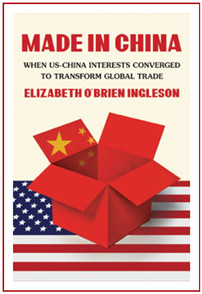
Made in China: When US-China Interests Converged to Transform Global Trade
Elizabeth O’Brien Ingleson
Harvard University Press, Cambridge, MA, 2024, 352 pp., $37.95
Focused on the pivotal period of the 1970s, Elizabeth O’Brien Ingleson’s Made in China reminds us of the roots of the complexities still present in today’s China-United States relationship and in global trade overall. She argues that the transformation of China’s market and the relationship between the two powers were enabled by three interlinking factors: cultural, diplomatic, and economic. Meticulously researched, the book describes how these factors played out in each country and in relation to each other to answer broader and more fundamental questions—not only about why China converged with US capitalism but also why American capitalists incorporated China into their vision of the future.
Rife with interesting and fresh anecdotes, the book takes us through the early days of an unsteady trading relationship trying to find its footing. Interspersed with broader observations about the political and diplomatic interworkings of this period are stories about US importers such as Veronica Yhap, founder of Dragon Lady Traders, and their role in promoting “fashion diplomacy”—an important contributor, Ingleson argues, to a diplomatic and commercial thaw between the countries. It also includes accounts of the early Canton Trade Fairs, providing a lens through which to view China’s internal struggles about the appropriate role of foreign trade while illuminating how US businesspeople saw China during that period.
Against this backdrop, Ingleson offers keen observations about the differing ways China and the United States incentivized trade during normalization. Henry Kissinger and President Richard M. Nixon understood trade as a mechanism for facilitating diplomacy, whereas Chairman Mao Zedong saw it as something that would follow only after addressing thorny diplomatic issues. This is a plausible explanation for why trade between the two nations began in fits and starts, taking off only once their respective interests were more fully aligned. It also highlights the outsize role diplomacy can play in shaping the trajectory of the global economy.
For anyone who follows China-US relations today, many of the themes in Made in China will ring familiar. This includes the Maoist concept of self-reliance—zili gengsheng—whose evolution is a theme Ingleson returns to throughout her account of this period. Given the geopolitical shocks of recent years and elevated trade tensions, this concept is once again prominent in Chinese policy documents, harking back to the early days of rapprochement described in the book. Ingleson describes how political hard-liners and so-called pragmatists clashed over China’s role in an evolving trade and geopolitical landscape.
Loading component...
Similarly, Ingleson takes us back to the early days of China’s efforts to import technological know-how, detailing the country’s 1973 purchase of Kellogg fertilizer plants. A quote by Lin Hujia, who was then vice director of China’s state planning commission, put a decision to pursue the deal in terms that ultimately proved pivotal for China’s development strategy: “Should we eat 2 million metric tons of imported wheat or buy 10 chemical fertilizer plants…I believe we all agree to buy the 10 fertilizer plants.”
Ingleson describes early wariness of Chinese imports by US organized labor—from the passage of the 1974 Trade Act to the quota petition by the Worker Glove Manufacturers Association—another thread with significant parallels to today.
Ultimately, Ingleson concludes that China-US relations converged at a time when both countries needed each other to meet their respective domestic and strategic objectives. At a time when China-US tensions are particularly fraught, Made in China reminds us that many of the challenges of today are not necessarily new. For the optimists among us, this may offer a glimmer of hope for a scenario in which each country incorporates the other into its respective vision of the future. And, in this regard, further study of how the three interlocking forces—cultural, diplomatic, and economic—have continued to evolve in more recent years would be illuminating.
Opinions expressed in articles and other materials are those of the authors; they do not necessarily reflect IMF policy.








